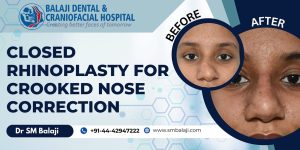History of malunited facial fractures after RTA surgery elsewhere
This young man had suffered injuries to his face with fractures from a motor bike accident. This happened in his hometown a few years ago. He had undergone emergent surgery, which resulted in a malunited nasal bone fracture. His nasal septum was also deviated to the left side. He has been suffering from breathing problems and snoring since then. He decided to get this corrected. A general dentist in his hometown referred him to our hospital for correction of his problem.
Treatment plan explained to the patient
The patient presented at our hospital for management of his multiple facial deformities. Dr. SM Balaji, Cranio-Maxillofacial surgeon examined the patient. He explained the treatment plan to the patient. This also involved harvesting a rib graft from the patient. The patient was in full agreement with the treatment plan.
Deviated nasal septum set right to correct breathing problems
Under general anesthesia, a rib graft was first harvested from the patient. A Valsalva test demonstrated patent thoracic cavity. The incision was then closed in layers. Attention was then turned to the nose. The deviated nasal septum was first refractured. A nasal speculum was then used to widen the nasal choanae. Intranasal incisions were then performed to avoid visible scarring.
Hardware from previous surgery removed
Attention was next turned to the zygomaticomaxillary bone. Maxillary vestibular incisions were then made in the buccal sulcus region. Old hardware from the previous surgery was exposed and removed. Sutures were then used to close the incisions.
Augmentation rhinoplasty performed
The rib graft was next crafted to fit into the bridge of the nose. Graft was then placed through the intranasal incision to fit into the bridge of the nose. This augmented the nasal bridge with precision. All incisions were then sutured.
Nostril breadth reduction surgery performed
Attention was next turned to the nostril reduction procedure for the patient. Crescent shaped incisions were then marked out at bilateral alar bases. The tissue was next incised and removed. The alar bases were then sutured closer to the midline. This resulted in narrowing of the nose.
The patient expressed his utmost satisfaction to Dr SM Balaji before final discharge. He said that his nasal form was back to its original shape.





